Requires Special Treatment Methods
Roof and Norway Rats
Rats comprises the target order of mammals, consisting of 2,230 species, three which were discovered as recently as 2009. This represents about 43 percent of all mammals. We will be reviewing the commensal rats and specifically the notorious Roof Rat and the Norway Rat.
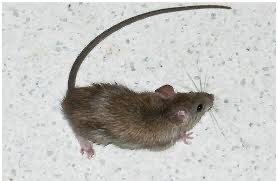
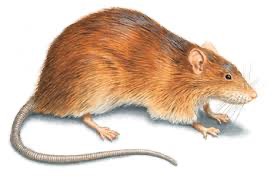
The commensal rodents as pests, the compete with us for many different types of resources, damage our building and infrastructures, and threaten public health. The Food and Agricultural Organization of the United nations reported that rats destroyed more than 42 million tons of food worth $30 billion. It has been repeatedly estimated that
Above (Roof Rat)
To Right (Norway Rat)
between one-fith to one-third of the world’s food supply never reaches the table due to losses from rodents. In some parts of the world, the entire crop grown for human consumption has been lost to rodents during outbreaks. Rats cause significant damage to our buildings and infrastructures as well as many of the everyday items humans use for their daily lives. The word rodent originates from the French word order, meaning “to gnaw.” Rodents use their powerful front incisor teeth as chisel tools to gnaw on a wide range of items and objects. As gnawing mammals, rodents inflict significant damage to structures, equipment, furniture, utilities, and transportation vehicles. Farmers and city dwellers in areas contains established populations of rats and mice are familiar with how rodents gnaw on truck, tractor, and car engine wires. Rats can gnaw through wood, aluminum sheathing, sheet rock, soft cement, asphalt, and soft metals such as lead and copper soft metals such as lead and copper. Thus, property owners and pest professionals of rat-infested areas routinely observe rat holes holes drilled into doors, floors, and ceiling. Rats also frequently gnaw through plastic water pipes and irrigation distribution systems to access the water.
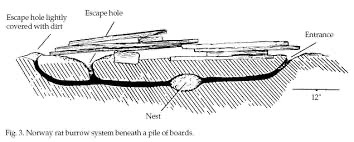
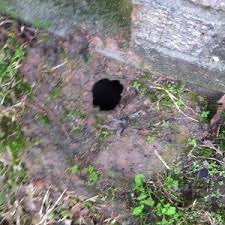
Their digging and tunneling through and beneath slabs, as well as isolation, also causes significant damage over time.
Entry Points Of Buildings Or Homes
Below is a helpful diagram of possible entry points of a home although not all conclusive it makes a good starting point. When inspecting your home for rodent activity you should look for gnawing marks, fur, and blackish/brown oil around openings and entry points listed in diagram where they travel through.
Attic And Crawl Spaces
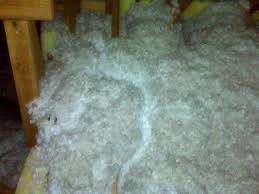
Be sure to inspect attic and crawl spaces for activity. Check for droppings from rats, see chart below for rat dropping identification. In the crawl space look for entry points and evidence of activity plugging access points whenever possible. In the attic look for insulation trails rats will follow the same path over and over and will
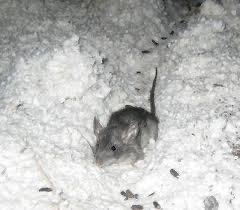
produce trails that look like someone had laid a flexible pipe across the insulation it will have rut like indentations and possibly have rat droppings in the trail see photos.
Rat Biology (Norway Rat and Roof)
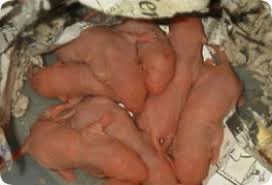
Female Norway rats reach sexual maturity in 75-90 days Their gestation period is 21 -25 days and average between 2 - 7 litters a year. The number of pups per litter range in average between 6 - 14. The total production per female is 36 - 39. The pups are weaned in approximately 28 days.
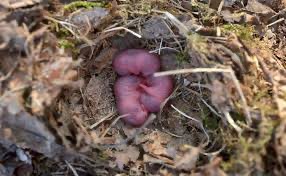
Female Roof rats reach sexual maturity in 68-90 days Their gestation period is 20 -23 days and average between 3 - 9 litters a year. The number of pups per litter range in average between 5 - 8. The total production per female is 31 - 34. The pups are weaned in approximately 28 days.
The female may be impregnated a few hours after birth of a litter and is possible for females to give birth every 24 to 28 days, rarely does this occur in wild populations.
The average life span of rats in the wild is about six months, with only about five out of 100 rats surviving up to 12 months of age.
Identification
Commensal rodents are not native to North America, they come with European settlers. The 2 species - Norway rat and the Roof rat - differ physically in many ways and are easily identified. The two commensal rodents are distinguished from native rodents by the characteristics of their tails. The tails of commensal rodents are scaly and sparsely covered with hair, those of native rodents have more hair and smaller scales.
Color alone is not a good identifying characteristic because fur color varies widely among rodents, even between individuals of the same species. Other way to distinguish among rodents is to check the relative length of the tail, body size, and the size of the ears
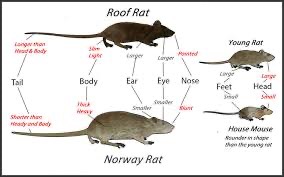
Chart
- A Roof rat’s tail is usually longer than its head and body. When the tail is stretched over the back, it extends past the nose. The Norway rat’s tail, however, does not extend past its nose when stretched over its back.
- A Roof rat’s ears also are large and conspicuous. Its yes are larger and set farther forward than the Norway rat’s
- A Norway rat’s body is heavier and stockier than that of the Roof rat, which has a pointed muzzle and a slim body.
- Juvenile rats are distinguished from adult house mice by their larger feet, heads and tails.
When inspecting look for droppings or feces it can help in the identification of the type of rodent(s) present.
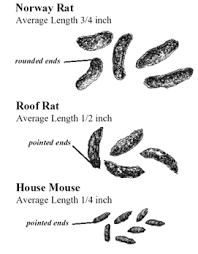
Norway rats feces are capsule-shaped and about 3/4 inch long.
Roof rats feces are about 1/2 inch long and are spindle-shaped.
The house mouse feces are about 0.12 to 1/4 inch long and are rod-shaped
Diseases
Rats continue to play a significant roll in the transmission of a large number of diseases to humans.History has shown the commensal rodents are responsible for some of the most devastating disease outbreaks of all time. More than 10 million people have died from rodent-borne diseases during the past century alone. The most important disease-causing organisms vectored by commensal rodents are:
- Murine Typhus
- The Plague
- Hantavirus
- Salmonellosis
- Trichinosis
- Leptospirosis
- Hemorrhagic Fever
- Ricketsialpox
- Rat-bite Fever
Rats also distribute many diseases to livestock, poultry and pets and include the following:
- Brucellosis
- Distemper
- Leptospirosis
- Trichinosis
- Equine Influenza
- Mange
- Mastitis
- Swine Erysipelas
- Tracheitis
- Tuberculosis
Note: Some of the above listed diseases can be vectored from Fleas and or Ticks that feed on Rats then humans and or pets and livestock.
Hiring Pest Management Professionals
Getting a pest management professional (PMP) involved as soon as possible rather than taking time to try to treat the problem yourself, they are very effective at preventing further infestations. Each pest management company should have instructions for residents on how to prepare for the treatment.